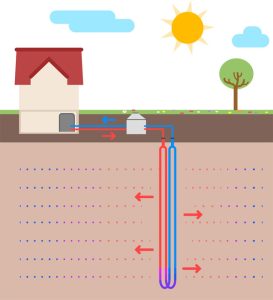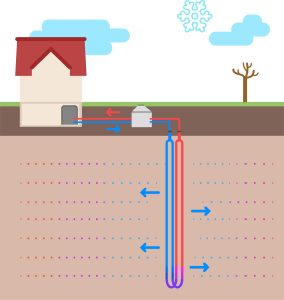A type of heating network that is operated at a low temperature level (approx. 5-15°C). The system uses uninsulated pipes in the ground and supplies decentralised heat pumps in the connected buildings with environmental heat.
Heat supply concept with low distribution temperatures and decentralised temperature increase.
A heat pump that absorbs heat from a brine-water mixture (the heat source) and raises it to a higher temperature level for heating and hot water. In the LTDHC, it is installed as a decentralised unit in each building.
Kennzahl für die Effizienz einer Wärmepumpe über ein ganzes Jahr. Sie gibt an, wie viel Wärmeenergie pro eingesetzter elektrischer Energie erzeugt wird. Je höher die JAZ, desto effizienter arbeitet die Wärmepumpe.
Vertical borehole (usually 50-200m deep) with an integrated heat exchanger pipe system for utilising geothermal energy. Used in the LTDHC as an additional heat source alongside the collector network.

The ability of the uninsulated pipework in the LTDHC to act as a ground heat exchanger itself and to absorb heat from the surrounding ground or release it to it.
The system's ability to transport heat in both directions - from the ground to the buildings for heating in winter and from the buildings to the ground for cooling in summer.
The ground around the pipework, which serves as a natural heat store. Heat stored in summer can be partially utilised again in winter.
The temperature of the heat transfer medium (brine) when it enters the heat pump from the network.
The temperature of the heat transfer medium after it has passed through the heat pump and flows back into the network.
The fluid that circulates in the LTDHC - usually a mixture of water and antifreeze (brine) to ensure safe operation even at temperatures below 0°C.
Regulating the network so that all connected buildings are supplied evenly with the required heat source output.
Measurement method for determining the thermal properties of the subsurface, important for the dimensioning of geothermal probes and the simulation of the overall system.
Heat distribution system in the building (e.g. underfloor heating) that can be operated efficiently with low flow temperatures - ideal for operation with heat pumps.
.
Heating system with flow temperatures below 55°C.
Key figure that indicates the maximum number of heat pumps that are active in the network at the same time. Important for dimensioning the overall system.
.
The heat demand of a building, which is made up of the heating load and hot water demand.
Direct utilisation of the cool brine from the network to cool the building without active operation of the heat pump, very energy-efficient.
The interplay of pressures and volume flows in the pipework system is important for the even distribution of thermal energy.
Technical equipment for the transition from the local heating network to the domestic installation.
Heating network with a low exergy level (low temperature), synonymous with cold local heating network.
Temperature level in the distribution network (typically 8-20°C).
Temperature difference between flow and return in the network.
Thermal energy from the environment (soil, groundwater, air).
Technical device for heat transfer between two media without direct mixing.